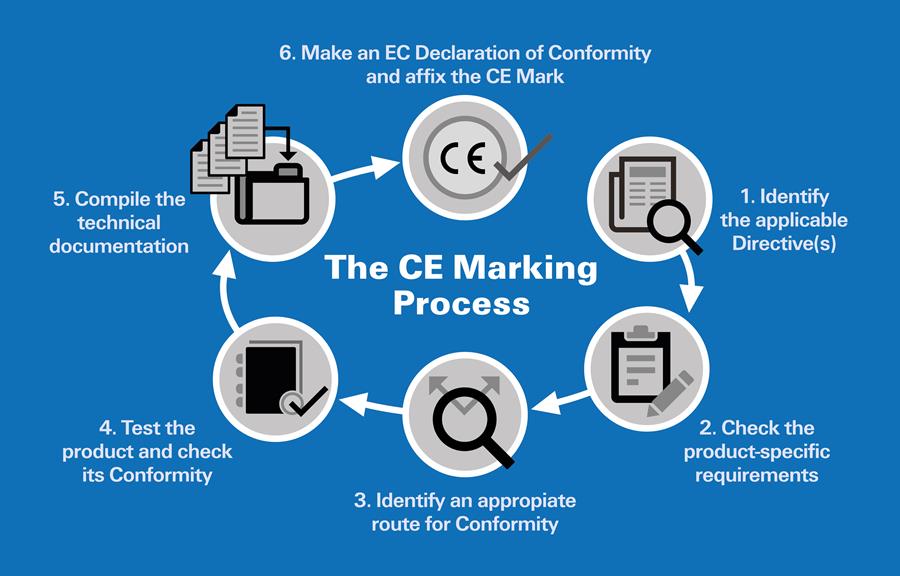Step to CE marking can be confusing, costly, complex, and can take up a lot of a company’s precious time. The six steps to CE marking from experts and Trade Commissioners alike, as well as key EU resources.
What is the CE marking?
CE stands for “Conformité Européenne”, the French for European conformity.
The CE marking is a symbol that a manufacturer affixes to a product so that it can be sold in Europe. The CE mark means that the manufacturer takes responsibility for the compliance of a product with all applicable European health, safety, performance and environmental requirements.
The mark is required in all 27 member states of the EU, as well as Iceland, Norway, and Liechtenstein. Switzerland accepts the CE mark for some products and Turkey actually requires that many products be CE marked.

Steps to CE Marking
1. Find the CE directives suitable for your products
Firstly, you must know your product is covered under one or more of the 24 CE directives below. If your product falls under any of these directives, it needs to be CE marked. You can find more on websites of the European Commission.
A directive is a legislative act of the European Union which requires member states to adapt their national laws to achieve a particular result that is harmonized to EU rules in this area.
Once you have figured out if your product falls under one or more directives, it’s time to assess if your product conforms to the applicable directives and, if not, how you will achieve conformity.
2. Know the essential requirements
Each directive details what the EU legally requires for your product to be compliant. These are formally referred to as “essential requirements” in the directive. These requirements are very general in nature. The directives do not detail how to design a product in a way that it meets the essential requirements.
The European Commission often provides mandates to European organizations (CEN, CENELEC and ETSI) to develop standards which are harmonized with the essential requirements of the directives. For information about the content and availability of these harmonized standards, contact the following organizations:
– CEN (European Committee for Standardization)
– CENELEC (European Committee for Electrotechnical Standardization)
– ETSI (European Telecommunications Standards Institute)
3. Determine if you need third-party assessment
Some directives require that products be tested and certified by a third-party organization in order to ensure their conformity with applicable essential requirements. Whereas these organizations are known worldwide as conformity assessment bodies, they are also known in Europe as notified bodies (NB). If applicable directives do not require the use of an NB, manufacturers may rely on their own in-house facilities to assess their product’s conformity.
4. Assess product conformity
You will have to test and document that your product actually conforms. Each directive outlines which conformity assessment procedures – also referred to as modules – a manufacturer can undertake. There are 8 conformity assessment modules. The applicable directives outline which module(s) apply for a particular product category.
Module A: Internal production control
Module B: EC type examination
Module C: Conformity to type
Module D: Production quality assurance
Module E: Product quality assurance
Module F: Product verification
Module G: Unit verification
Module H: Full quality assurance (EN ISO 9001)
5. Create and maintain technical documentation
All CE marking directives impose an obligation for the manufacturer to create and make available technical documentation (or a technical file) containing information that demonstrates the product conforms to the requirements of the directive.
Technical documentation relevant to a CE-marked product must be kept for at least 10 years from the last date the product was manufactured, unless the directive provides for a later date. The technical documentation must be provided on demand to enforcement authorities, often within short timelines. The technical documentation needs to be kept up-to-date, especially when the product is modified or is subject to updated conformity assessment procedures.

6. Declaration of Conformity & affixing the CE mark
The document certifying compliance with CE marking directives is the Declaration of Conformity. The Declaration of Conformity is an acknowledgement by the manufacturer that they are responsible for the compliance of its products with the applicable directives.
This document is the manufacturer’s sole responsibility, and the establishment of the Declaration of Conformity is a legal obligation.
The declaration should be available to authorities at the EU point of entry. Contrary to the complete technical documentation, the Declaration of Conformity should be made available to EU distributors, who may be required to provide it to national authorities immediately upon request.
Affixing the CE mark
The CE mark must be: affixed to all new products, whether manufactured in the Member States or in third countries; to used and second-hand products imported from third countries; and to substantially modified products that are subject to directives as new products.
Directives may exclude the application of the CE mark on certain products (specified below), even if the directive otherwise applies to the product. These specific exceptions vary from directive to directive.
The CE mark must be easily seen and accessible for all parties. It could, for instance, be affixed on the back or underside of a product. A minimum height of 5 mm is required to ensure that it is legible. It shall also be indelible so that it cannot be removed under normal circumstances without leaving noticeable traces. (For example, some product standards use a rub test with water and petroleum spirits). However, this does not mean that the CE mark must form an integral part of the product.
Contact us
Ha Noi Office:
Tầng 4, Tòa nhà 78 Nguyễn Hoàng, P. Mỹ Đình 2, Q. Cầu Giấy, Hà Nội
Tel: 024-39996088 Fax: 024- 62580411
Email: info@eurocert.com.vn
Ho Chi Minh Office:
Tầng 9, Số 68, Nguyễn Huệ, P. Bến Nghé, Q.1, Tp. Hồ Chí Minh
Tel: 028-62760286
Email: hcm@eurocert.com.vn
>>> Read more: CE process







